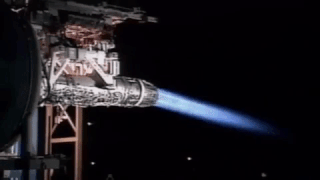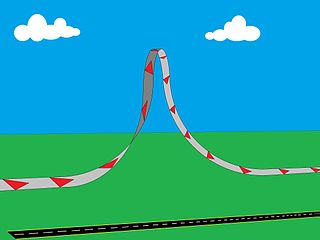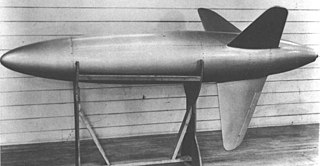
An aileron is a hinged flight control surface usually forming part of the trailing edge of each wing of a fixed-wing aircraft. Ailerons are used in pairs to control the aircraft in roll, which normally results in a change in flight path due to the tilting of the lift vector. Movement around this axis is called 'rolling' or 'banking'.

The National Advisory Committee for Aeronautics (NACA) was a United States federal agency founded on March 3, 1915, to undertake, promote, and institutionalize aeronautical research. On October 1, 1958, the agency was dissolved and its assets and personnel were transferred to the newly created National Aeronautics and Space Administration (NASA). NACA is an initialism, i.e., pronounced as individual letters, rather than as a whole word.

An autopilot is a system used to control the path of an aircraft, marine craft or spacecraft without requiring constant manual control by a human operator. Autopilots do not replace human operators. Instead, the autopilot assists the operator's control of the vehicle, allowing the operator to focus on broader aspects of operations.

Elevons or tailerons are aircraft control surfaces that combine the functions of the elevator and the aileron, hence the name. They are frequently used on tailless aircraft such as flying wings. An elevon that is not part of the main wing, but instead is a separate tail surface, is a stabilator.

The Northrop/McDonnell Douglas YF-23 is an American single-seat, twin-engine, supersonic stealth fighter aircraft technology demonstrator designed for the United States Air Force (USAF). The design was a finalist in the USAF's Advanced Tactical Fighter (ATF) competition, battling the Lockheed YF-22 for a production contract. Two YF-23 prototypes were built.

The Northrop X-4 Bantam was a prototype small twinjet aircraft manufactured by Northrop Corporation in 1948. It had no horizontal tail surfaces, depending instead on combined elevator and aileron control surfaces for control in pitch and roll attitudes, almost exactly in the manner of the similar-format, rocket-powered Messerschmitt Me 163 of Nazi Germany's Luftwaffe. Some aerodynamicists had proposed that eliminating the horizontal tail would also do away with stability problems at fast speeds resulting from the interaction of supersonic shock waves from the wings and the horizontal stabilizers. The idea had merit, but the flight control systems of that time prevented the X-4 from achieving any success.

Thrust vectoring, also known as thrust vector control (TVC), is the ability of an aircraft, rocket or other vehicle to manipulate the direction of the thrust from its engine(s) or motor(s) to control the attitude or angular velocity of the vehicle.

The 9K31 Strela-1 is a highly mobile, short-range, low altitude infra-red guided surface-to-air missile system. Originally developed by the Soviet Union under the GRAU designation 9K31, it is commonly known by its NATO reporting name, SA-9 "Gaskin". The system consists of a BRDM-2 amphibious vehicle, mounting two pairs of ready-to-fire 9M31 missiles.

The Aggregat series was a set of ballistic missile designs developed in 1933–1945 by a research program of Nazi Germany's Army (Heer). Its greatest success was the A4, more commonly known as the V2.

Ship stabilizers are fins or rotors mounted beneath the waterline and emerging laterally from the hull to reduce a ship's roll due to wind or waves. Active fins are controlled by a gyroscopic control system. When the gyroscope senses the ship roll, it changes the fins' angle of attack so that the forward motion of the ship exerts force to counteract the roll. Fixed fins and bilge keels do not move; they reduce roll by hydrodynamic drag exerted when the ship rolls. Stabilizers are mostly used on ocean-going ships.
Adverse yaw is the natural and undesirable tendency for an aircraft to yaw in the opposite direction of a roll. It is caused by the difference in lift and drag of each wing. The effect can be greatly minimized with ailerons deliberately designed to create drag when deflected upward and/or mechanisms which automatically apply some amount of coordinated rudder. As the major causes of adverse yaw vary with lift, any fixed-ratio mechanism will fail to fully solve the problem across all flight conditions and thus any manually operated aircraft will require some amount of rudder input from the pilot in order to maintain coordinated flight.

A barrel roll is an aerial maneuver in which an airplane makes a complete rotation on both its longitudinal and lateral axes, causing it to follow a helical path, approximately maintaining its original direction. It is sometimes described as a "combination of a loop and a roll". The g-force is kept positive on the object throughout the maneuver, commonly between 2 and 3g, and no less than 0.5g. The barrel roll is commonly confused with an aileron roll.
In aeronautics, inertia coupling, also referred to as inertial coupling and inertial roll coupling, is a potentially catastrophic phenomenon of high-speed flight which caused the loss of aircraft and pilots before the design features to counter it were understood. It occurs when the inertia of a heavy fuselage exceeds the ability of the aerodynamic forces and moments generated by the wing and empennage to stabilize the aircraft. The problem became apparent as jet fighter aircraft and research aircraft were developed with narrow wingspans, that had relatively low roll inertia, caused by a long slender high-density fuselage, compared to the pitch and yaw inertias.

Ship stabilizing gyroscopes are a technology developed in the 19th century and early 20th century and used to stabilize roll motions in ocean-going ships. It lost favor in this application to hydrodynamic roll stabilizer fins because of reduced cost and weight. However, since the 1990s, there is renewed interest in the device for low-speed roll stabilization of vessels. Unlike traditional fins, the gyroscope does not rely on the forward speed of the ship to generate a roll stabilizing moment and therefore can stabilize motor yachts while at anchor. However, the latest generation of "zero speed" fins stabilizers can stabilize yachts while at anchor thanks to their eccentricity with respect of the shaft.

The MAA-1 Piranha is a short-range infrared homing missile and the first air-to-air missile developed by Brazil for its Air Force and Navy. It was designed to replace the AIM-9 Sidewinder missile in Brazilian service and has since been exported to Colombia, Indonesia and Pakistan.

The AIM-9 Sidewinder is a short-range air-to-air missile. Entering service with the United States Navy in 1956 and the Air Force in 1964, the AIM-9 is one of the oldest, cheapest, and most successful air-to-air missiles. Its latest variants remain standard equipment in most Western-aligned air forces. The Soviet K-13, a reverse-engineered copy of the AIM-9B, was also widely adopted.

The National Aeronautics and Space Administration (NASA) was created in 1958 from the National Advisory Committee for Aeronautics (NACA), and other related organizations, as the result of the Space Race between the United States and the Soviet Union in the 1950s.
As the coalition of Bay Areas counties predicted when it lobbied for the creation of Moffett Federal Airfield in the late 1920s, the base's research program and facilities catalyzed the development of numerous private technology and aerospace corporations, among them Lockheed Martin and the Hiller Aircraft Corporation.

The JB-3 Tiamat was subsonic air-to-air missile program that began in January 1944 for the U.S. Army Air Force under project MX-570. Prime contractor was Hughes Aircraft Company Electronics Division which developed the Tiamat with the assistance of the National Advisory Committee for Aeronautics, (NACA).

The TDU-12/B Skydart was an unguided target rocket built by Curtiss-Wright for use by the United States Air Force. It was used operationally from the late 1950s to the mid-1960s.



















